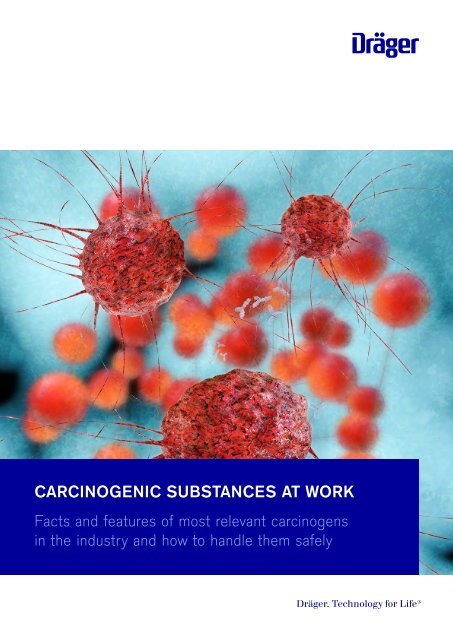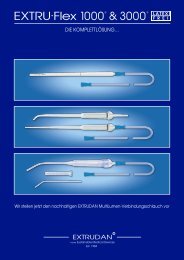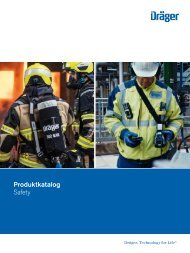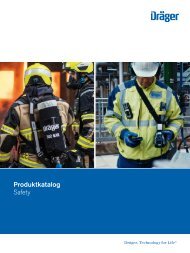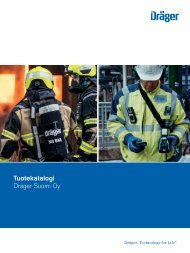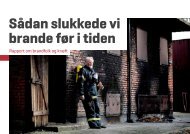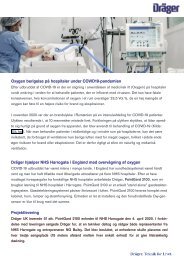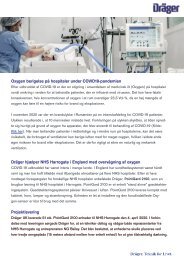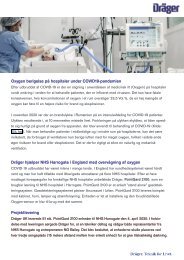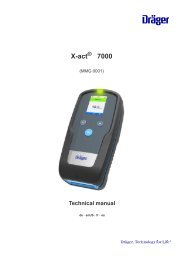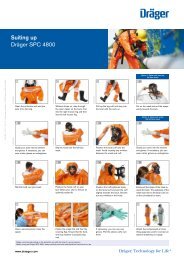Carcinogenic Substances at Work
Create successful ePaper yourself
Turn your PDF publications into a flip-book with our unique Google optimized e-Paper software.
CARCINOGENIC SUBSTANCES AT WORK<br />
Facts and fe<strong>at</strong>ures of most relevant carcinogens<br />
in the industry and how to handle them safely
TABLE OF CONTENTS<br />
TABLE OF CONTENTS<br />
1<br />
2<br />
3<br />
4<br />
5<br />
6<br />
7<br />
8<br />
9<br />
10<br />
11<br />
12<br />
13<br />
CARCINOGENIC SUBSTANCES AT WORK<br />
Introduction -------------------------------------------------------------------------------------------------- 03<br />
10 FACTS ABOUT OCCUPATIONAL CARCINOGENS<br />
The "time bombs" among hazardous substances in the workplace. ------------------------- 04<br />
ACRYLONITRILE<br />
C3H3N -------------------------------------------------------------------------------------------------------- 08<br />
BENZENE<br />
C6H6 ----------------------------------------------------------------------------------------------------------- 10<br />
1,3-BUTADIENE<br />
C4H6 ----------------------------------------------------------------------------------------------------------- 12<br />
EPICHLOROHYDRIN<br />
C3H5CIO ----------------------------------------------------------------------------------------------------- 14<br />
ETHYLENE OXIDE<br />
C2H4O -------------------------------------------------------------------------------------------------------- 16<br />
FORMALDEHYDE<br />
CH2O ---------------------------------------------------------------------------------------------------------- 18<br />
MERCURY<br />
Hg -------------------------------------------------------------------------------------------------------------- 20<br />
VINYL CHLORIDE MONOMER<br />
C2H3CI -------------------------------------------------------------------------------------------------------- 22<br />
MEASURING CARCINOGENS<br />
Cre<strong>at</strong>e a safer workplace -------------------------------------------------------------------------------- 24<br />
THE RIGHT PPE FOR THE JOB<br />
Protecting your workers from carcinogens --------------------------------------------------------- 29<br />
DEAR READER<br />
Disclaimer ---------------------------------------------------------------------------------------------------- 32<br />
2 | 30
CARCINOGENIC SUBSTANCES AT WORK<br />
CARCINOGENIC<br />
SUBSTANCES AT WORK<br />
Introduction<br />
Studies estim<strong>at</strong>e more than 700.000 de<strong>at</strong>hs<br />
worldwide due to occup<strong>at</strong>ional cancer – per<br />
year. Th<strong>at</strong> is more than the number of de<strong>at</strong>hs<br />
due to global conflict, terrorism and homicide<br />
combined.<br />
The culprits are carcinogens: A variety<br />
of substances th<strong>at</strong> may cause cancer<br />
after exposure. There are several forms<br />
of carcinogens, for example chemical<br />
carcinogens like vinyl chloride or benzene, or<br />
processes th<strong>at</strong> may cause exposure such as<br />
fine particles from diesel exhaust.<br />
Carcinogens may enter the body through<br />
inhal<strong>at</strong>ion or exposure to skin and can spread<br />
to different organs by way of the bloodstream.<br />
Once carcinogens enter the body they can<br />
damage or alter the DNA of cells or the<br />
way cells work or replic<strong>at</strong>e, which may lead<br />
to cancer. While everybody encounters<br />
possible carcinogens in their daily life (like<br />
UV radi<strong>at</strong>ion or car exhaust), occup<strong>at</strong>ional<br />
exposure to carcinogens poses a higher<br />
risk of cancer development. This is due to<br />
the recurring exposure and the potentially<br />
higher levels continuing through the time of<br />
employment.<br />
The exposure to carcinogens not only puts<br />
the health and life of workers in danger, it<br />
also cre<strong>at</strong>es additional neg<strong>at</strong>ive effects for<br />
companies and employers by thre<strong>at</strong>ening<br />
the workers productivity levels and work<br />
particip<strong>at</strong>ion. This makes protecting<br />
employees from carcinogens the responsibility<br />
of every employer and HSE manager.<br />
The good news is, th<strong>at</strong> occup<strong>at</strong>ional cancer is<br />
avoidable. By taking appropri<strong>at</strong>e measures the<br />
burden of cancer can be significantly reduced.<br />
Employees must be protected as effectively as<br />
possible against cancer risk factors. This can<br />
be done cost-efficiently by using an intelligent<br />
measuring str<strong>at</strong>egy, precise measuring<br />
techniques and by offering employees suitable<br />
personal protection equipment.<br />
This paper helps as a starting point, by<br />
introducing you into the world of carcinogens,<br />
showing some of the most used carcinogens<br />
in the chemical industry and providing an<br />
overview to different measuring approaches<br />
and suitable protective equipment.<br />
3 | 30 33
10 FACTS ABOUT OCCUPATIONAL CARCINOGENS<br />
10 FACTS ABOUT<br />
OCCUPATIONAL CARCINOGENS<br />
The "time bombs" among hazardous substances in the workplace.<br />
1<br />
WHAT ARE CARCINOGENS?<br />
The Encyclopedia Britannica defines<br />
carcinogens as any number of agents<br />
th<strong>at</strong> can cause cancer in humans. They can be<br />
divided into three major c<strong>at</strong>egories: chemical<br />
carcinogens (including those from biological<br />
sources), physical carcinogens, and oncogenic<br />
(cancer-causing) viruses. 1<br />
2<br />
HOW CARCINOGENS<br />
CAUSE CANCER.<br />
Most Carcinogens cause cancer<br />
by interacting with cell DNA and thereby<br />
interfering with normal cellular function,<br />
causing genetic abnormalities to develop in<br />
the normal cell 2 . With cancer, cells go out of<br />
control, multiply without order, and invade<br />
and destroy the surrounding tissue. 3 This can<br />
result in the form<strong>at</strong>ion of a tumor, an abnormal<br />
tissue growth th<strong>at</strong> may spread to other parts of<br />
the body.<br />
3<br />
CARCINOGENS POSE<br />
A LIFELONG RISK.<br />
Carcinogens do not cause cancer in<br />
every case. <strong>Substances</strong> labeled as carcinogens<br />
may have different levels of cancer-causing<br />
potential. It is true th<strong>at</strong> a large amount of a<br />
cancer-causing substance leads to cancer much<br />
more frequently. But even very small doses<br />
can develop a harmful effect – although the<br />
probability is clearly lower. The risk of developing<br />
cancer due to contact with a carcinogen remains<br />
throughout one‘s lifetime, since in many cases<br />
cell damage does not develop until years<br />
after contact with the substance. The time<br />
between exposure to a carcinogen and the<br />
onset of the disease can be up to 50 years. 4<br />
For any particular individual person, the risk of<br />
developing cancer depends on many factors –<br />
including how they are exposed to a carcinogen,<br />
the length and intensity of th<strong>at</strong> exposure, and<br />
the person´s genetic makeup.<br />
How cancer develops<br />
1<br />
Boundary<br />
2<br />
3<br />
Lymph vessel<br />
Blood vessel<br />
3<br />
1<br />
2<br />
Normal cells<br />
Abnormals cells<br />
1.2 million years<br />
! of life were lost<br />
due to prem<strong>at</strong>ure<br />
de<strong>at</strong>h caused by<br />
past exposure<br />
to carcinogenic<br />
substances <strong>at</strong> work<br />
in the EU. 5<br />
Abnormals cells multiply<br />
Malignant or invasive cancer<br />
4 | 33
10 FACTS ABOUT OCCUPATIONAL CARCINOGENS<br />
4<br />
HOW MANY CARCINOGENS<br />
ARE THERE?<br />
The Intern<strong>at</strong>ional Agency for Research<br />
on Cancer has classified agents into several<br />
groups, sorted by the probability of them<br />
causing cancer. As of April 2020, 120 agents<br />
have been classified as carcinogenic, with<br />
another 83 agents probably being carcinogenic<br />
to humans. 6<br />
5<br />
CARCINOGEN,<br />
YES OR NO?<br />
Detecting the cancer-gener<strong>at</strong>ing<br />
property of a chemical agent is often very<br />
difficult. It is not ethical to test a substance<br />
by exposing people to it and seeing if they<br />
get cancer. Th<strong>at</strong>’s why scientists must use<br />
other types of tests – which may not always<br />
give clear answers. For example, it is not<br />
easy to deduce whether or not a substance is<br />
carcinogenic from animal testing. Rodents and<br />
humans often react to chemical substances<br />
in entirely different ways. 19 out of 20 test<br />
substances th<strong>at</strong> are considered safe for<br />
humans cause cancer in rodents. 7 However,<br />
of 19 substances known to cause cancer in<br />
humans, only seven prove to be carcinogenic<br />
in rodents. 8<br />
This is why multiple sources should be used<br />
and combined, such as:<br />
• Lab studies in animals and examin<strong>at</strong>ions<br />
• Tests and lab studies of human cell cultures<br />
• Human case and epidemiologic studies and<br />
observ<strong>at</strong>ions from practice<br />
6<br />
CANCER IS A MAJOR HEALTH<br />
HAZARD IN THE WORKPLACE.<br />
Occup<strong>at</strong>ional cancer represents the<br />
primary cause for work-rel<strong>at</strong>ed de<strong>at</strong>hs globally. 9<br />
52% of all work-rel<strong>at</strong>ed de<strong>at</strong>hs in the EU and<br />
27% globally are caused<br />
by occup<strong>at</strong>ional cancer. 10 Every year, an<br />
estim<strong>at</strong>ed 742,000 de<strong>at</strong>hs occur globally<br />
due to work-rel<strong>at</strong>ed cancer. Th<strong>at</strong> is more<br />
than the total number of de<strong>at</strong>hs caused by<br />
Malaria in 2017. 11/12<br />
Agents Classified by the IARC<br />
Monographs, Volumes 1–125<br />
Group 1<br />
<strong>Carcinogenic</strong> to humans<br />
120 agents<br />
Group 2A<br />
Probably carcinogenic to human<br />
83 agents<br />
Group 2B<br />
Possibly carcinogenic to human<br />
314 agents<br />
Group 3<br />
Not classifiable as to its carcinogenicity<br />
to humans<br />
500 agents<br />
Percentage of all work-rel<strong>at</strong>ed de<strong>at</strong>hs<br />
Cancer<br />
Circul<strong>at</strong>ory<br />
Injuries<br />
Others<br />
31%<br />
*De<strong>at</strong>hs due to MSDs are<br />
included in Other illnesses<br />
14%<br />
Global estim<strong>at</strong>e<br />
2%<br />
22%<br />
28%<br />
24%<br />
27%<br />
EU28 estim<strong>at</strong>e<br />
52%<br />
5 | 33
10 FACTS ABOUT OCCUPATIONAL CARCINOGENS<br />
Certain cancers and associ<strong>at</strong>ed workplace exposure 13<br />
12 Nasal Sinus Cancer<br />
Laryngeal Cancer 5 13 Nasopharynx Cancer<br />
8 Lung Cancer<br />
Liver Cancer<br />
11<br />
7<br />
Mesothelioma<br />
Chlolangiocarcinoma 3 4 Kidney cancer<br />
14 Ovarian Cancer<br />
Bladder cancer 1<br />
7<br />
THE CHEMICAL INDUSTRY IS<br />
SUBJECT TO A PARTICULARLY<br />
HIGH RISK.<br />
From benzene to formaldehyde and acid<br />
aerosols: <strong>Carcinogenic</strong> substances are found<br />
in many areas of the chemical industry. The<br />
protection of employees from carcinogens is<br />
therefore one of the central challenges for<br />
occup<strong>at</strong>ional health and safety.<br />
Breakdown of <strong>Work</strong>-Rel<strong>at</strong>ed Mortality<br />
by United N<strong>at</strong>ions Geographical Regions in 2015 11<br />
Europe<br />
126,127<br />
Asia<br />
430,472<br />
1<br />
2<br />
8<br />
4-Aminodiphenyl, Benzidine,<br />
beta-Naphthylamine,<br />
ortho-Toluidine<br />
Ionizing radi<strong>at</strong>ion, Radium,<br />
Plutonium<br />
3 1,2-Dichloropropane<br />
4 Trichloroethylene<br />
5 Asbestos, sulfuric acid mists<br />
6<br />
7<br />
Leukemia<br />
Lymphoma,<br />
Non-Hodgkin<br />
Melanoma<br />
Skin Cancer<br />
Benzene, 1,3-Butadiene,<br />
Formaldehyde, Ionizing<br />
radi<strong>at</strong>ion<br />
Afl<strong>at</strong>oxins, Vinyl chloride,<br />
Plutonium<br />
6<br />
9<br />
10<br />
15<br />
9<br />
10<br />
1,3-Butadiene, Lindane,<br />
Pentachlorophenol<br />
Radi<strong>at</strong>ion, solar and ultraviolet,<br />
Polychlorin<strong>at</strong>ed biphenyls<br />
11 Asbestos, Erionite<br />
12<br />
Nickel refining (nickel oxides and<br />
sulfides), Le<strong>at</strong>her dust, Wood<br />
dusts, Radium (dial painting)<br />
13 Formaldehyde, Wood dusts<br />
14 Asbestos<br />
Arsenic and compounds, Asbestos, Beryllium and compounds, Cadmium<br />
and compounds, bis-Chloromethyl ether, Chloromethyl methyl ether,<br />
Chromium compounds<br />
2<br />
15<br />
Bone cancer<br />
Radi<strong>at</strong>ion (solar and ultraviolet),<br />
Ionizing radi<strong>at</strong>ion, Arsenic and<br />
compounds<br />
America<br />
128,020<br />
Africa<br />
46,494<br />
8<br />
OCCUPATIONAL CANCER IS<br />
MORE COMMON THAN<br />
PREVIOUSLY THOUGHT.<br />
Epidemiological studies indic<strong>at</strong>e th<strong>at</strong><br />
occup<strong>at</strong>ional exposures cause 5.3–8.4 percent<br />
of all cancers. 14<br />
2014 37.6% of workers in Australia are<br />
affected by occup<strong>at</strong>ional carcinogens. 11<br />
Oceania<br />
7,645<br />
2019 Carcinogens <strong>at</strong> the workplace are<br />
responsible for over 10,000 cancer cases<br />
diagnosed in Canada each year. 15<br />
2016 More than 120,000 people in the EU<br />
are diagnosed with cancer, caused by past<br />
exposure to carcinogenic substances <strong>at</strong> work,<br />
per year. 5<br />
2017 In 2017 68,396 de<strong>at</strong>hs were <strong>at</strong>tributed<br />
to occup<strong>at</strong>ional cargcinogens in China. 16<br />
6 | 33
10 FACTS ABOUT OCCUPATIONAL CARCINOGENS<br />
9<br />
BINDING OCCUPATIONAL<br />
EXPOSURE LIMITS BRINGS<br />
GREATER SAFETY.<br />
Most people know th<strong>at</strong> asbestos is a potential<br />
cancer thre<strong>at</strong> in the workplace. But wh<strong>at</strong><br />
about trichloroethylene, benzene, or the<br />
various chromium compounds? The European<br />
Trade Institute has listed 71 cancer-causing<br />
substances th<strong>at</strong> constitute 80 to 90% of the<br />
carcinogens to which people may be exposed<br />
in the workplace. 18<br />
10<br />
PROTECT YOUR WORKERS.<br />
Protecting your workers from<br />
carcinogens is not only the morally<br />
right decision, it is the financially prudent one.<br />
In the European Union health care expenditure<br />
and productivity losses due to work-rel<strong>at</strong>ed<br />
cancer are estim<strong>at</strong>ed to be approxim<strong>at</strong>ely<br />
€4.4 billion per year. 5 Companies all over<br />
the world had to pay settlements of millions<br />
of dollars, for exposing their workers to<br />
carcinogens above the legal limit.<br />
Cancers causally associ<strong>at</strong>ed with<br />
occup<strong>at</strong>ional carcinogens 19<br />
Lung cancer<br />
Skin cancer<br />
Bone cancer<br />
Bladder cancer<br />
7%<br />
9%<br />
10%<br />
23%<br />
Benefits of <strong>Work</strong>force Health Promotion 20<br />
To the organis<strong>at</strong>ion<br />
To the employee<br />
reduced staff turnover<br />
improved morale<br />
increased productivity<br />
increased skills<br />
for health protection<br />
a well-managed health<br />
and safety program<br />
a safe and healthy work environment<br />
improved staff morale<br />
reduced stress<br />
a positive and caring image<br />
enhanced self-esteem<br />
reduced absenteeism<br />
increased job s<strong>at</strong>isfaction<br />
Cancers of the nasal cavity and paranasal sinuses<br />
6%<br />
reduced risk of fines and litig<strong>at</strong>ion<br />
improved sense of well-being<br />
reduced health<br />
care/insurance costs<br />
improved health<br />
1 The Editors of Encyclopaedia Britannica. (2019, July 8). Carcinogen. Retrieved May 6, 2020, from https://www.britannica.com/science/carcinogen<br />
2 Determining if Something Is a Carcinogen. (n.d.). Retrieved May 6, 2020, from https://www.cancer.org/cancer/cancer-causes/general-info/determining-if-something-is-a-carcinogen.html<br />
3 Understanding cancer. (n.d.). Retrieved May 6, 2020, from https://cancerqld.org.au/cancer-inform<strong>at</strong>ion/learn-to-cope/wh<strong>at</strong>-is-cancer/<br />
4 European Commission & Director<strong>at</strong>e-General for Employment, Social Affairs and Inclusion. (2016, May 13). COMMISSION STAFF WORKING DOCUMENT – Impact assessment accompanying<br />
the Proposal for a DIRECTIVE OF THE EUROPEAN PARLIAMENT AND OF THE COUNCIL amending Directive 2004/37/EC on the protection of workers from the risks rel<strong>at</strong>ed to exposure to<br />
carcinogens or mutagens <strong>at</strong> work. Retrieved May 6, 2020, from https://eur-lex.europa.eu/legal-content/EN/TXT/HTML/?uri=CELEX:52016SC0152&rid=3<br />
5 N<strong>at</strong>ional Institute for Public Health and the Environment. (n.d.). <strong>Work</strong>-rel<strong>at</strong>ed cancer in the European Union. Retrieved from https://www.rivm.nl/bibliotheek/rapporten/2016-0010.pdf<br />
6 Intern<strong>at</strong>ional Agency for Research on Cancer (IARC). (2020, February 18). Agents Classified by the IARC Monographs, Volumes 1–125. Retrieved May 6, 2020, from https://monographs.<br />
iarc.fr/agents-classified-by-the-iarc/<br />
7 Ennever FK, Noonan TJ, Rosenkranz HS. The predictivity of animal bioassays and short-term genotoxicity tests for carcinogenicity and anon-carcinogenicity to humans. Mutagenesis. 1987<br />
Mar;2(2):73-78<br />
8 Salsburg, D. The Lifetime Feeding Study in Mice and R<strong>at</strong>s – An Examin<strong>at</strong>ion of Its Validity as a Bioassay for Human Carcinogens. Fundamental & Applied Toxicology 1983;3:63-67<br />
9 Iavicoli S, Driscoll TR, Hogan M, et al New avenues for prevention of occup<strong>at</strong>ional cancer: a global policy perspective; Occup<strong>at</strong>ional and Environmental Medicine 2019;76:360-362<br />
10 EU OSHA. (n.d.). The economics of occup<strong>at</strong>ional safety and health – the value of OSH to society. Retrieved May 6, 2020, from https://visualis<strong>at</strong>ion.osha.europa.eu/osh-costs#!/<br />
11 Hämäläinen P, Takala J, Saarela KL. Global estim<strong>at</strong>es of f<strong>at</strong>al work-rel<strong>at</strong>ed diseases. Am J Ind Med. 2007;50(1):28-41. http://www.icohweb.org/site/images/news/pdf/Report%20Global%20<br />
Estim<strong>at</strong>es%20of%20Occup<strong>at</strong>ional%20Accidents%20and%20<strong>Work</strong>-rel<strong>at</strong>ed%20Illnesses%202017%20rev1.pdf<br />
12 Number of de<strong>at</strong>hs by cause. (n.d.). Retrieved May 6, 2020, from https://ourworldind<strong>at</strong>a.org/grapher/annual-number-of-de<strong>at</strong>hs-by-cause<br />
13 Causal Agent-Cancer Links in Haz-Map. (2019, December 16). Retrieved May 6, 2020, from https://www.haz-map.com/cancer.htm<br />
14 Furuya S, Chimed-Ochir O, Takahashi K, David A, Takala J. Global Asbestos Disaster. Int J Environ Res Public Health. 2018;15(5):1000. Published 2018 May 16. doi:10.3390/ijerph15051000<br />
15 Occup<strong>at</strong>ional Cancer Research Centre. Burden of occup<strong>at</strong>ional cancer in Canada: Major workplace carcinogens and prevention of exposure. Toronto, ON: 2019<br />
16 Li J, Yin P, Wang H, et al. The disease burden <strong>at</strong>tributable to 18 occup<strong>at</strong>ional risks in China: an analysis for the global burden of disease study 2017. Environ Health. 2020;19(1):21. Published 2020<br />
Feb 19. doi:10.1186/s12940-020-00577-y<br />
17 Global trend according to estim<strong>at</strong>ed number of occup<strong>at</strong>ional accidents and f<strong>at</strong>al work-rel<strong>at</strong>ed diseases <strong>at</strong> region and country level. (2009). Journal of Safety Research, 40(2), 125–139. doi: https://<br />
doi.org/10.1016/j.jsr.2008.12.010<br />
18 Wriedt, H. (2016). Carcinogens th<strong>at</strong> should be subject to binding limits on workers exposure. Brussels: ETUI, European Trade Union Institute.<br />
19 Loomis D, Guha N, Hall AL, Straif K. Identifying occup<strong>at</strong>ional carcinogens: an upd<strong>at</strong>e from the IARC Monographs. Occup Environ Med. 2018;75(8):593-603. doi:10.1136/oemed-2017-104944<br />
20 <strong>Work</strong>place health promotion. (2010, December 8). Retrieved May 6, 2020, from https://www.who.int/occup<strong>at</strong>ional_health/topics/workplace/en/index1.html<br />
7 | 33
ACRYLONITRILE<br />
ACRYLONITRILE<br />
C 3 H 3 N<br />
WHAT IS ACRYLONITRILE?<br />
Acrylonitrile is a colourless liquid with<br />
a pungent odour. 1 It is utilized in the<br />
manufacturing of dissolver, emulsifier<br />
and adhesive, but it is mainly used in the<br />
production of plastics. 2<br />
ACRYLONITRILE: FLAMMABLE,<br />
CORROSIVE, TOXIC AND<br />
CARCINOGENIC<br />
Acrylonitrile is a carcinogenic substance with<br />
acutely toxic effects since it can form deadly<br />
cyanide. In contact with substances like<br />
bromine, chlorine or strong bases, there is also<br />
risk of explosion. 1<br />
GHS06<br />
GHS02<br />
GHS08<br />
GHS05<br />
GHS09<br />
Acrylonitrile is a substance th<strong>at</strong> it highly<br />
flammable, sensitive to light, very reactive and<br />
tends to polymerize spontaneously. Exposure<br />
to acrylonitrile poses acute or chronic hazards<br />
to health. <strong>Carcinogenic</strong> substances like<br />
Acrylonitrile should only be used in closed<br />
appar<strong>at</strong>us — any contact with the substance<br />
should be avoided. 1 The danger of Acrylonitrile<br />
to the human body and n<strong>at</strong>ure is described<br />
by the H-st<strong>at</strong>ements enshrined in GHS/CLP<br />
regul<strong>at</strong>ions. They are intern<strong>at</strong>ionally valid.<br />
CAUTION ACRYLIONITRILE<br />
CAUSES CANCER!<br />
Acrylonitrile is primarily absorbed by inhal<strong>at</strong>ion<br />
and via skin contact. Even close contact with<br />
a person who is affected with Acrylonitrile<br />
can harm others. Lung cancer is associ<strong>at</strong>ed<br />
with acrylonitrile exposure <strong>at</strong> the workplace.<br />
The EU classifies Acrylonitrile as a human<br />
carcinogen of the c<strong>at</strong>egory 1B, while the<br />
IARC classifies it as "possibly carcinogenic to<br />
humans". 3 Typical symptoms of acute toxicity<br />
include eye, airway, and skin irrit<strong>at</strong>ion, as well<br />
as neurotoxic effects such as disorders of the<br />
central nervous system.<br />
H225<br />
H350<br />
H331<br />
H311<br />
H301<br />
H361<br />
H335<br />
H315<br />
H318<br />
H317<br />
H411<br />
Highly flammable liquid and vapour<br />
May cause cancer<br />
Toxic if inhaled<br />
Toxic in contact with skin<br />
Toxic if swallowed<br />
Suspected of damaging fertility or<br />
the unborn child<br />
May cause respir<strong>at</strong>ory irrit<strong>at</strong>ion<br />
Causes skin irrit<strong>at</strong>ion<br />
Causes serious eye damage<br />
May cause an allergic skin reaction<br />
Toxic to aqu<strong>at</strong>ic life with longlasting<br />
effects<br />
8 | 33
ACRYLONITRILE<br />
Acrylonitrile – chemical and<br />
physical properties¹<br />
CAS no.<br />
Appearance and colour:<br />
Odour threshold:<br />
Melting point:<br />
Boiling point:<br />
Flash point/flash point range:<br />
Flammability:<br />
Explosion thresholds:<br />
LEL (lower explosion limit)<br />
UEL (upper explosion limit):<br />
107-13-1<br />
Pungent<br />
3.7–35.8 ppm<br />
-82 °C<br />
77 °C<br />
-5 °C<br />
Highly flammable<br />
2.8 vol.%<br />
28 vol.%<br />
SELECTED INTERNATIONAL WORKPLACE EXPOSURE<br />
LIMITS FOR ACRYLONITRILE (8 HOURS TWA)<br />
Country/Region Parts per million Mg/m³<br />
Europe 0.45 1<br />
Germany (acceptance level) 0.12 0.26<br />
Germany (tolerance level) 1.2 2.6<br />
USA (ACGIH) 2 4.3<br />
China (PC-STEL CN) – 2<br />
China (PC-TWA CN) – 1<br />
Singapore 2 PEL (LT) 4.3 PEL (LT)<br />
Is your country not included? <br />
Visit our hazardous substances d<strong>at</strong>abase VOICE for more<br />
inform<strong>at</strong>ion: www.draeger.com/voice<br />
MEASUREMENT OF<br />
ACRYLONITRILE<br />
Usually acrylonitrile synthesis and<br />
processing take place in a closed<br />
system. For continuous area<br />
monitoring for timely warning of leaks<br />
it is advisable to use permanently<br />
installed gas measurement devices<br />
with electrochemical sensors.<br />
Employees working in <strong>at</strong>-risk areas<br />
should be provided with a personal<br />
gas-measuring device th<strong>at</strong> uses<br />
an OV-A sensor. Regular room<br />
air samples can be taken with a<br />
detection tube and evalu<strong>at</strong>ed with the<br />
help of a Dräger-Tube® (Acrylonitrile<br />
0.5/a) and a pump.<br />
Dräger X-am® 8000<br />
Dräger Polytron® 7000<br />
Dräger Pac® 8000<br />
Dräger Short-term Tubes<br />
Find more inform<strong>at</strong>ion about suitable measuring equipment in<br />
the chapter "Measuring carcinogens".<br />
1 IFA. (n.d.). GESTIS Substance d<strong>at</strong>abase - Acrylonitrile. Gestis Substance D<strong>at</strong>abase. Retrieved July 3, 2020, from http://gestis-en.itrust.de/nxt/g<strong>at</strong>eway.dll/gestis_en/000000.<br />
xml?f=templ<strong>at</strong>es$fn=default.htm$vid=gestiseng:sdbeng$3.0<br />
2 Lumitos GmbH. (n.d.). Acrylnitril. Chemie.De. Retrieved July 3, 2020, from https://www.chemie.de/lexikon/Acrylnitril.html<br />
3 Agency for Toxic <strong>Substances</strong> & Disease Registry. (2011, March 3). Acrylonitrile. Toxic <strong>Substances</strong> Portal. https://www.<strong>at</strong>sdr.cdc.gov/substances/toxsubstance.asp?toxid=78<br />
4 European Chemicals Agency. (2018, August). Opinion on scientific evalu<strong>at</strong>ion of occup<strong>at</strong>ional exposure limits for Acrylonitrile (ECHA/RAC/ O-0000001412-86-188/F). ECHA. https://echa.<br />
europa.eu/documents/10162/13641/acrylonitrile_opinion_en.pdf/102477c9-a961-2c96-5c4d-76fcd856ac19<br />
9 | 33
BENZENE<br />
BENZENE<br />
C 6 H 6<br />
WHAT IS BENZENE?<br />
Benzene is a colourless liquid with a<br />
characteristic odour. 1 When exposed to air<br />
it quickly evapor<strong>at</strong>es. The chemical and<br />
pharmaceutical industries use it primarily as a<br />
solvent and a starting m<strong>at</strong>erial or intermedi<strong>at</strong>e<br />
in the production of plastics, lubricants,<br />
rubbers, drugs and others.<br />
Furthermore, benzene is a n<strong>at</strong>ural component<br />
of crude oil and gasoline. 2<br />
BENZENE: FLAMMABLE, TOXIC AND<br />
CARCINOGENIC<br />
Benzene belongs to the BTEX family alongside<br />
toluene, ethylbenzene, and xylene. They<br />
are also called arom<strong>at</strong>ics because of their<br />
sweet odour, which is often described as<br />
pleasant. Benzene evapor<strong>at</strong>es easily and can<br />
be detected due to its distinctive smell <strong>at</strong><br />
concentr<strong>at</strong>ions between 2.5 and 5 parts per<br />
million in air.<br />
<strong>Work</strong>ers are exposed to benzene in (petro-)<br />
chemical plants, oil refineries, coke works<br />
foundries and storage (distribution and use<br />
of petrol or benzene itself). Benzene is a<br />
hazardous carcinogen and is subject to very<br />
strict workplace thresholds.<br />
Most non-industrial applic<strong>at</strong>ions of benzene<br />
have been limited, but it still belongs to the<br />
largest commodity of organic chemicals.<br />
Employees must receive the best level of<br />
protection against any type of exposure.<br />
Furthermore, benzene vapor and air together<br />
form a heavy and explosive compound.<br />
The danger of benzene to the human body<br />
is described by the H-st<strong>at</strong>ements enshrined<br />
in GHS/CLP regul<strong>at</strong>ions, which are<br />
intern<strong>at</strong>ionally valid.<br />
GHS02 GHS07 GHS08<br />
H225<br />
H304<br />
H315<br />
H319<br />
H340<br />
H350<br />
H372<br />
H412<br />
Highly flammable liquid and vapor<br />
May be f<strong>at</strong>al if swallowed and<br />
enters airways<br />
Causes skin irrit<strong>at</strong>ion<br />
Causes serious eye irrit<strong>at</strong>ion<br />
May cause genetic defects<br />
May cause cancer<br />
Causes damage to organs through<br />
prolonged or repe<strong>at</strong>ed exposure<br />
Harmful to aqu<strong>at</strong>ic life with<br />
long-lasting effects<br />
CAUTION BENZENE CAUSES CANCER!<br />
Benzene has serious effects on the human<br />
body. Prolonged exposure can cause organ<br />
damage and genetic defects. Benzene is<br />
also highly carcinogenic and is classified as a<br />
group 1 carcinogen. Typical forms of cancer<br />
caused by benzene exposure are leukemia<br />
and lymphoma.<br />
10 | 33
BENZENE<br />
Benzene – chemical and physical properties 1<br />
SELECTED INTERNATIONAL WORKPLACE EXPOSURE<br />
LIMITS FOR BENZENE (8 HOURS TWA)<br />
CAS no. 71-43-2<br />
Appearance and colour:<br />
Odour:<br />
Odour threshold:<br />
Melting point:<br />
Boiling point:<br />
Flash point/flash point range:<br />
Flammability:<br />
Explosion thresholds:<br />
LEL (lower explosion limit)<br />
UEL (upper explosion limit):<br />
Liquid, colourless<br />
Arom<strong>at</strong>ic<br />
Approx. 5 ppm<br />
6 °C<br />
80 °C<br />
-11 °C<br />
Liquid and vapour<br />
highly flammable<br />
1.2 vol-%<br />
8.6 vol-%<br />
MEASUREMENT OF BENZENE<br />
Detecting arom<strong>at</strong>ic hydrocarbons is not easy – particularly<br />
in low concentr<strong>at</strong>ions or as part of compounds. The choice<br />
of measurement method (selective or non-selective)<br />
depends on the measuring task (e.g. leak searches,<br />
workplace monitoring, pre-entry-measurement) and the<br />
measuring quality desired. The lower the workplace limits,<br />
the more challenging the measurement process.<br />
Country/Region Parts per million Mg/m³<br />
Europe 1 3.25<br />
Germany (acceptance level) 0.06 0.2<br />
Germany (tolerance level) 0.6 1.9<br />
USA (ACGIH)<br />
STEL: 2.5<br />
TWA: 0.5<br />
Benzene<br />
Dräger X-act® 7000<br />
TWA: 1.6<br />
TWA: 8<br />
China (PC-STEL CN) – 10<br />
China (PC-TWA CN) – 6<br />
Singapore 1 PEL (LT) 3.18 PEL (LT)<br />
Is your country not included? <br />
Visit our hazardous substances d<strong>at</strong>abase VOICE for more<br />
inform<strong>at</strong>ion: www.draeger.com/voice<br />
Dräger X-pid®<br />
9000/9500<br />
Several selective and non-selective methods or an<br />
intelligent combin<strong>at</strong>ion of it are suitable. A multi gas<br />
detector with PID sensor measures the cumul<strong>at</strong>ive<br />
concentr<strong>at</strong>ion of existing VOCs in a non-selective way.<br />
For frequent selective random samples the analysis mode<br />
of the Dräger X-pid® 9000 or if less frequent, several<br />
Dräger Short-term Tubes like Benzene 2/a can be used.<br />
Spot measurements of concentr<strong>at</strong>ions down to 0.15 ppm<br />
can be done with the Dräger X-act® 7000.<br />
Dräger X-am® 8000<br />
Dräger Shortterm<br />
Tubes<br />
Find more inform<strong>at</strong>ion about suitable measuring<br />
equipment in the chapter "Measuring carcinogens".<br />
1 IFA. (n.d.-a). Benzene. Gestis Substance D<strong>at</strong>abase. Retrieved July 3, 2020, from http://gestis-en.itrust.de/nxt/g<strong>at</strong>eway.dll/gestis_en/000000.xml?f=templ<strong>at</strong>es$fn=default.<br />
htm$vid=gestiseng:sdbeng$3.0<br />
2 The Facts on Benzene. (2020, March 30). Roadmap on Carcinogens. https://roadmaponcarcinogens.eu/benzene/<br />
3 Drägerwerk AG & Co. KGaA. (n.d.). Benzene . Dräger VOICE D<strong>at</strong>abank. Retrieved July 3, 2020, from https://www.draeger.com/en_seeur/Applic<strong>at</strong>ions/VOICE/<strong>Substances</strong>/37<br />
11 | 33
1,3-BUTADIENE<br />
1,3-BUTADIENE<br />
C 4 H 6<br />
WHAT IS 1,3-BUTADIENE?<br />
1,3-Butadiene is a colourless gas with a<br />
mild arom<strong>at</strong>ic or gasoline-like odour. In the<br />
chemicals industry, 1,3-butadiene is primarily<br />
used to manufacture mineral oil products,<br />
synthetic rubber 1 and other rubber goods, it is<br />
also used to produce rocket fuel Typical end<br />
products include vessel linings, tubing and<br />
car tyres. 2<br />
1,3-BUTADIENE: FLAMMABLE, TOXIC<br />
AND CARCINOGENIC<br />
Concentr<strong>at</strong>ed accumul<strong>at</strong>ions of 1,3-butadiene<br />
cannot be recognised by the naked eye due<br />
to a lack of colour. As it is heavier than air,<br />
1,3-butadiene accumul<strong>at</strong>es <strong>at</strong> floor level.<br />
If inhaled in large doses it has a narcotic<br />
effect. Explosive compounds form in the<br />
presence of air.<br />
Caution: 1,3-butadiene has a low boiling point!<br />
The main route of exposure is thus inhal<strong>at</strong>ion in<br />
gaseous form, as an aerosol, or vapour. Special<br />
respir<strong>at</strong>ory protection filters are necessary.<br />
The danger of 1,3-butadiene to the human<br />
body and production equipment is described<br />
by the H-st<strong>at</strong>ements enshrined in GHS/CLP<br />
regul<strong>at</strong>ions. They are intern<strong>at</strong>ionally valid.<br />
CAUTION 1,3-BUTADIENE<br />
CAUSES CANCER!<br />
1,3-butadiene is primarily absorbed via the<br />
respir<strong>at</strong>ory p<strong>at</strong>hways. There are chronic effects<br />
from long-term exposure above the defined<br />
workplace thresholds, including the risk of<br />
leukaemia and other tumours, such as non-<br />
Hodgkin lymphoma. 5<br />
The EU classifies 1,3-butadiene as a human<br />
carcinogen of carcinogenicity c<strong>at</strong>egory 1. The<br />
American EPA also r<strong>at</strong>es the substance as a<br />
GHS02 GHS04 GHS08<br />
H220<br />
H280<br />
H340<br />
H350<br />
Extremely flammable gas<br />
Contains gas under pressure<br />
May cause genetic effects<br />
May cause cancer (c<strong>at</strong>egory 1)<br />
human carcinogen; in the ACGIH ranking it is<br />
Group A2: Suspected human carcinogen. 3<br />
Skin contact or inhal<strong>at</strong>ion of the gas after<br />
a direct discharge from pressure vessels is<br />
known to cause symptoms of acute toxicity,<br />
such as localised frostbite and irrit<strong>at</strong>ion. In<br />
very high concentr<strong>at</strong>ions, a narcotic effect is<br />
possible. 6<br />
12 | 33
1,3-BUTADIENE<br />
1,3-Butadiene – chemical and<br />
physical properties⁴<br />
CAS no. 106-99-0<br />
Appearance and colour:<br />
Odour:<br />
Odour threshold:<br />
Melting point:<br />
Boiling point:<br />
Flash point/flash point range:<br />
Risk of explosion:<br />
Explosion thresholds:<br />
LEL (lower explosion limit)<br />
UEL (upper explosion limit):<br />
Gaseous,<br />
colourless<br />
Arom<strong>at</strong>ic<br />
< 76 ppm<br />
-108.92 °C<br />
-4.5 °C<br />
-85 °C<br />
Upon contact with<br />
various substances<br />
1.4 vol-%<br />
16.3 vol-%<br />
SELECTED INTERNATIONAL WORKPLACE EXPOSURE<br />
LIMITS FOR 1,3-BUTADIENE (8 HOURS TWA)<br />
Country/Region Parts per million Mg/m³<br />
Germany (acceptance level) – 5<br />
Germany (tolerance level) 0,2 0,5<br />
USA (ACGIH) 2 5<br />
China (PC-STEL CN) 1 2,2<br />
China (PC-TWA CN) 2 4,4<br />
Singapore 2 4,4<br />
Is your country not included? <br />
Visit our hazardous substances d<strong>at</strong>abase VOICE for more<br />
inform<strong>at</strong>ion: www.draeger.com/voice<br />
MEASUREMENT OF 1,3-BUTADIEN<br />
<strong>Work</strong>ing in an 1,3-butadiene exposed area requires an<br />
exact measurement, assessment and monitoring of the<br />
butadiene concentr<strong>at</strong>ion of the workplace/warehouse<br />
<strong>at</strong> floor level, such as via a gas warning system with<br />
OV, C<strong>at</strong>-Ex or IR sensors. For clearance measurement,<br />
repe<strong>at</strong>ed spot measurements and individual workplace<br />
monitoring several selective and non-selective methods<br />
are suitable. A multi gas detector with PID sensor<br />
measures the cumul<strong>at</strong>ive concentr<strong>at</strong>ion of existing VOCs<br />
in a non-selective way. For selective random samples the<br />
analysis mode of the Dräger X-pid® 9000 or a Dräger<br />
Short-term Tube like Chloropren 5/a can be used. Spot<br />
measurements of concentr<strong>at</strong>ions down to 25 ppb can<br />
be done with the Dräger X-act® 7000. To identify the<br />
average concentr<strong>at</strong>ion <strong>at</strong> a workplace a diffusion tube<br />
like Butadien 10/a-D is a good choice.<br />
Dräger X-pid®<br />
9000/9500<br />
Dräger X-am® 8000<br />
Dräger Polytron® 7000<br />
Dräger Shortterm<br />
Tubes<br />
Find more inform<strong>at</strong>ion about suitable measuring<br />
equipment in the chapter "Measuring carcinogens".<br />
1 http://www.chemie.de/lexikon/Butadien.html; accessed: 31.08.2017<br />
2 http://www.spektrum.de/lexikon/chemie/kautschuk/4818: accessed: 31.08.2017<br />
3 https://www.osha.gov/SLTC/butadiene/healtheffects.html; accessed: 31.08.2017<br />
4 Source: GESTIS substance d<strong>at</strong>abase; www.gestis.de; accessed: 31.08.2017<br />
5 Source: GESTIS substance d<strong>at</strong>abase; www.gestis.de; accessed: 31.08.2017<br />
6 Source: GESTIS substance d<strong>at</strong>abase; www.gestis.de; accessed: 31.08.2017<br />
7 No indic<strong>at</strong>ed threshold due to potential carcinogenic effect. Source: https://www.cdc.gov/niosh/idlh/106990.html; accessed: 31.08.2017<br />
8 https://www.cdc.gov/niosh/idlh/106990.html; accessed: 31.08.2017<br />
9 http://limitvalue.ifa.dguv.de; accessed: 20.06.2016<br />
10 Source (unless otherwise indic<strong>at</strong>ed): GESTIS substance d<strong>at</strong>abase; www.gestis.de; accessed: 31.08.2017<br />
11 No indic<strong>at</strong>ed threshold due to potential carcinogenic effect. Source: https://www.cdc.gov/niosh/idlh/106990.html; accessed: 31.08.2017<br />
12 https://www.cdc.gov/niosh/idlh/106990.html; accessed: 31.08.2017<br />
13 http://limitvalue.ifa.dguv.de; accessed: 20.06.2016<br />
13 | 33
EPICHLOROHYDRIN<br />
EPICHLOROHYDRIN<br />
C 3 H 5 CIO<br />
WHAT IS EPICHLOROHYDRIN?<br />
Epichlorohydrin is a clear colourless liquid<br />
with an irrit<strong>at</strong>ing, chloroform-like odour. It is<br />
used to manufacture epoxy resins, elastomers,<br />
and synthetic glycerin.1 It is also used in the<br />
manufacture of other chemicals, insecticides,<br />
co<strong>at</strong>ings, adhesives, and as a solvent in the<br />
rubber industry.<br />
GHS02<br />
GHS05<br />
EPICHLOROHYDRIN: FLAMMABLE,<br />
CORROSIVE, AND CARCINOGENIC<br />
Epichlorohydrin is a flammable liquid th<strong>at</strong> is<br />
highly vol<strong>at</strong>ile. When he<strong>at</strong>ed above its flash<br />
point, its vapors may cause explosive reactions<br />
when combined with air.2<br />
GHS06<br />
GHS08<br />
Short-term inhal<strong>at</strong>ion exposure in the<br />
workplace can cause irrit<strong>at</strong>ion to the eyes,<br />
respir<strong>at</strong>ory tract, and skin of workers. Nausea,<br />
vomiting, coughing, labored bre<strong>at</strong>hing,<br />
inflamm<strong>at</strong>ion of the lung, pulmonary edema,<br />
and renal lesions may be observed after<br />
high levels of exposure. Chronic (longterm)<br />
occup<strong>at</strong>ional exposure of humans<br />
to epichlorohydrin in air is associ<strong>at</strong>ed with<br />
high levels of respir<strong>at</strong>ory tract illness and<br />
hem<strong>at</strong>ological effects.1<br />
The EU and EPA have r<strong>at</strong>ed epichlorohydrin<br />
as a probable human carcinogen.1 The danger<br />
epichlorohydrin poses to the human body<br />
and production equipment is described by<br />
the H-st<strong>at</strong>ements as part of the GHS/CLP<br />
regul<strong>at</strong>ions. They are intern<strong>at</strong>ionally valid<br />
CAUTION EPICHLOROHYDRIN<br />
CAUSES CANCER!<br />
The acute toxicity of epichlorohydrin is<br />
demonstr<strong>at</strong>ed in severe irritant effects on the<br />
human body. As it has not yet been established<br />
whether single exposure to the substance can<br />
lead to an increased r<strong>at</strong>e of cancer, or whether<br />
H226<br />
H301<br />
H311<br />
H331<br />
H314<br />
H317<br />
H350<br />
Flammable liquid and vapor<br />
Toxic if swallowed, in contact<br />
with skin or if inhaled<br />
Causes severe skin burns<br />
and eye damage<br />
May cause an allergic skin reaction<br />
May cause cancer<br />
this is more likely to occur in the case of longterm<br />
exposure, exposure should essentially<br />
be minimised. 10 According to EU regul<strong>at</strong>ion,<br />
epichlorohydrin is r<strong>at</strong>ed as carcinogen class<br />
1B, meaning it is suspected to cause cancer.<br />
Animal testing indic<strong>at</strong>es a coherence between<br />
exposure to epichlorohydrin and tumors in the<br />
respir<strong>at</strong>ory system as well as in the central<br />
nervous system (CNS).2<br />
14 | 33
EPICHLOROHYDRIN<br />
Epichlorohydrin – chemical and<br />
physical properties2<br />
CAS no. 106-89-8<br />
SELECTED INTERNATIONAL WORKPLACE EXPOSURE<br />
LIMITS FOR EPICHLOROHYDRIN (8 HOURS TWA)<br />
Country/Region Parts per million Mg/m³<br />
Appearance and colour:<br />
Odour:<br />
Odour threshold:<br />
Melting point:<br />
Boiling point:<br />
Flash point/flash point range:<br />
Flammability:<br />
Explosion thresholds:<br />
LEL (lower explosion limit)<br />
UEL (upper explosion limit):<br />
Liquid, colourless<br />
Pungent,<br />
like chloroform<br />
–<br />
-48°C<br />
116°C<br />
28°C<br />
385°C<br />
2.3 vol-%<br />
34.4 vol-%<br />
Europe – 1.9<br />
Germany (acceptance level) 0.6 2.3<br />
Germany (tolerance level) 2 8<br />
USA (ACGIH) 0.5 1.9<br />
China (PC-STEL CN) – 2<br />
China (PC-WA CN) – 1<br />
Singapore 2 PEL (LT) 7.6 PEL (LT)<br />
Is your country not included? <br />
Visit our hazardous substances d<strong>at</strong>abase VOICE for more<br />
inform<strong>at</strong>ion: www.draeger.com/voice<br />
MEASUREMENT OF EPICHLOROHYDRIN<br />
Employees in dangerous areas should be<br />
equipped with their own gas measuring device<br />
with an OV sensor. Securely installed gas<br />
measuring heads with electrochemical sensors<br />
are used to continuously monitor the areas<br />
to ensure compliance with the occup<strong>at</strong>ional<br />
exposure limit value.<br />
If epichlorohydrin is one of a mixture of<br />
substances, an activ<strong>at</strong>ed charcoal sampling<br />
tube can give inform<strong>at</strong>ion about the<br />
composition. Concentr<strong>at</strong>ions above 5 pm can<br />
be determined with an epichlorohydrin 5/c<br />
short-term tube. Caution! As a major route<br />
of entry is via the skin, when working in<br />
areas with epichlorohydrin, regardless of the<br />
concentr<strong>at</strong>ion, the body should be protected by<br />
Dräger Pac® 8000<br />
Dräger X-am® 8000<br />
Dräger Polytron® 7000<br />
Dräger Shortterm<br />
Tubes<br />
Find more inform<strong>at</strong>ion about suitable measuring<br />
equipment in the chapter "Measuring carcinogens".<br />
a splash suit or a gas-tight chemical protective<br />
suit. Protective eyewear and protective gloves<br />
are also recommended.<br />
1 N<strong>at</strong>ional Center for Biotechnology Inform<strong>at</strong>ion. PubChem D<strong>at</strong>abase. Epichlorohydrin, CID=7835, https://pubchem.ncbi.nlm.nih.gov/compound/Epichlorohydrin (accessed on July 3, 2020)<br />
2 IFA. (n.d.-a). Epichlorohydrin. Gestis Substance D<strong>at</strong>abase. Retrieved July 3, 2020, from http://gestis-en.itrust.de/nxt/g<strong>at</strong>eway.dll/gestis_en/000000.xml?f=templ<strong>at</strong>es$fn=default.<br />
htm$vid=gestiseng:sdbeng$3.0<br />
3 Drägerwerk AG & Co. KGaA. (n.d.). Epichlorohydrin . Dräger VOICE D<strong>at</strong>abank. Retrieved July 3, 2020, from https://www.draeger.com/en_seeur/Applic<strong>at</strong>ions/VOICE/<strong>Substances</strong>/200<br />
15 | 33
ETHYLENE OXIDE<br />
ETHYLENE OXIDE<br />
C 2 H 4 O<br />
WHAT IS ETHYLENE OXIDE?<br />
Ethylene oxide is a gaseous, colourless<br />
substance th<strong>at</strong> smells like ether <strong>at</strong> toxic<br />
levels. 1,2 It is used in the manufacture of<br />
antifreeze, textiles, solvents, adhesives and<br />
pharmaceuticals.<br />
A primary use of ethylene oxide is as a<br />
chemical intermedi<strong>at</strong>e in the manufacture of<br />
ethylene glycol. 2 More than 40,000 workers<br />
in the European Union have potentially been<br />
exposed to ethylene oxide. 2<br />
GHS02<br />
GHS06<br />
GHS04<br />
GHS08<br />
ETHYLENE OXIDE: FLAMMABLE, TOXIC,<br />
AND HAZARDOUS TO HEALTH<br />
Danger of explosion: Ethylene oxide is<br />
extremely flammable, chemically unstable and<br />
may react explosively in the presence of an<br />
ignition source, even without oxygen. 1<br />
H220<br />
H230<br />
H280<br />
H331<br />
Extremely flammable gas<br />
May react explosively even in<br />
the absence of air<br />
Contains gas under pressure;<br />
may explode if he<strong>at</strong>ed<br />
Toxic if inhaled<br />
Acute effects and early symptoms of exposure<br />
to ethylene oxide include: eye pain, sore<br />
thro<strong>at</strong>, difficulty bre<strong>at</strong>hing, blurred vision,<br />
dizziness, nausea, headache, convulsions,<br />
blisters, vomiting, coughing, increased risk of<br />
miscarriage in females, testicular degener<strong>at</strong>ion<br />
and reduced sperm concentr<strong>at</strong>ion in males.<br />
Prolonged exposure may cause leukaemia,<br />
lymphoid or breast cancer. 2<br />
Caution: Ethylene oxide has a low boiling<br />
point! The main route of exposure is thus<br />
inhal<strong>at</strong>ion in gaseous form, as an aerosol, or<br />
vapour. Special respir<strong>at</strong>ory protection filters<br />
are necessary.<br />
The dangers of ethylene oxide to the human<br />
body and production equipment is described<br />
by the H-st<strong>at</strong>ements enshrined in GHS/CLP<br />
regul<strong>at</strong>ions. They are intern<strong>at</strong>ionally valid.<br />
H315<br />
H319<br />
H335<br />
H340<br />
H350<br />
H372<br />
Causes skin irrit<strong>at</strong>ion<br />
Causes serious eye irrit<strong>at</strong>ion<br />
May cause respir<strong>at</strong>ory irrit<strong>at</strong>ion<br />
May cause genetic defects<br />
May cause cancer<br />
Causes damage to organs through<br />
prolonged or repe<strong>at</strong>ed exposure<br />
CAUTION ETHYLENE OXIDE<br />
CAUSES CANCER!<br />
Ethylene oxide is a carcinogen (classified as<br />
group 1 by IARC) which may cause leukaemia,<br />
lymphoid and breast cancers. L<strong>at</strong>ency period<br />
between exposure and ethylene oxide-rel<strong>at</strong>ed<br />
cancer varies between 9 and 20 years. 2<br />
16 | 33
ETHYLENE OXIDE<br />
Ethylene oxide – chemical and<br />
physical properties 1<br />
SELECTED INTERNATIONAL WORKPLACE EXPOSURE<br />
LIMITS FOR ETHYLENE OXIDE (8 HOURS TWA)<br />
CAS no.<br />
Appearance and colour:<br />
Odour:<br />
Odour threshold:<br />
Melting point:<br />
Boiling point:<br />
75-21-8<br />
Gaseous,<br />
colourless<br />
Sweet, ethereal<br />
>500 ppm<br />
-112.55 °C<br />
10.5 °C<br />
Country/Region Parts per million Mg/m³<br />
Europe 1 1.8<br />
Germany (acceptance level) 0.1 0.2<br />
Germany (tolerance level) 1 2<br />
USA (ACGIH) 1 1.8<br />
Flash point/flash point range:<br />
Risk of explosion:<br />
Explosion thresholds:<br />
LEL (lower explosion limit)<br />
UEL (upper explosion limit):<br />
-57 °C<br />
Chemically unstable,<br />
highly reactive;<br />
risk of explosion<br />
2.6 vol-%<br />
100 vol-%<br />
China – 2<br />
Singapore 1 PEL (LT) 1.8 PEL (LT)<br />
Is your country not included? <br />
Visit our hazardous substances d<strong>at</strong>abase VOICE for more<br />
inform<strong>at</strong>ion: www.draeger.com/voice<br />
MEASURING ETHYLENE OXIDE<br />
Monitoring of the Ethylene Oxide concentr<strong>at</strong>ion<br />
of the workplace/warehouse should be done<br />
<strong>at</strong> floor level via a gas warning system with an<br />
OV sensor. A multi-gas detection device with<br />
OV sensor is suitable for continuous personal<br />
workplace monitoring. Spot measurements of<br />
concentr<strong>at</strong>ions down to 25 ppb can be done<br />
with the Dräger X-act® 7000. For frequent<br />
random samples the use of the analysis mode<br />
of the Dräger X-pid® 9000 is a good choice.<br />
For less frequent measurements short-term<br />
tubes such as Ethylene Oxide 1/a are able to<br />
measure concentr<strong>at</strong>ions of as low as 0.2 ppm.<br />
For workplace samples, the use of an active<br />
charcoal sampling tube is especially useful<br />
where there are mixtures of substances.<br />
Dräger X-pid®<br />
9000/9500<br />
Dräger X-am® 8000<br />
Dräger Polytron® 7000<br />
Dräger X-act® 7000<br />
Find more inform<strong>at</strong>ion about suitable measuring<br />
equipment in the chapter "Measuring carcinogens".<br />
1 IFA. (n.d.-a). Ethylene oxide. Gestis Substance D<strong>at</strong>abase. Retrieved July 8, 2020, from http://gestis-en.itrust.de/nxt/g<strong>at</strong>eway.dll/gestis_en/000000.xml?f=templ<strong>at</strong>es$fn=default.<br />
htm$vid=gestiseng:sdbeng$3.0<br />
2 The Facts on Ethylene Oxide. (n.d.). Roadmap on Carcinogens. Retrieved July 8, 2020, from https://roadmaponcarcinogens.eu/ethyleneoxide3<br />
17 | 33
FORMALDEHYDE<br />
FORMALDEHYDE<br />
CH 2 O<br />
WHAT IS FORMALDEHYDE?<br />
Formaldehyde is gaseous, colourless and has<br />
a pungent odour. 1 It is often found in w<strong>at</strong>erbased<br />
solutions. Formaldehyde is used in the<br />
manufacture of a wide variety of products<br />
like chemicals, glues, fibreboard adhesives<br />
and sealants, co<strong>at</strong>ing products, polymers<br />
and labor<strong>at</strong>ory chemicals. 2,3 It is also used<br />
as a preserv<strong>at</strong>ive in medical labor<strong>at</strong>ories and<br />
mortuaries. 2<br />
FORMALDEHYDE: EXTREMELY<br />
FLAMMABLE, EXPLOSIVE AND<br />
CARCINOGENIC<br />
According to the harmonised classific<strong>at</strong>ion and<br />
labelling approved by the European Union,<br />
formaldehyde is toxic in contact with skin,<br />
causes severe skin burns and eye damage,<br />
is toxic if inhaled, may cause cancer, and is<br />
suspected of causing genetic defects. 3<br />
Acute exposure to formaldehyde is highly<br />
irrit<strong>at</strong>ing to the eyes, nose, and thro<strong>at</strong>.<br />
Subsequent exposure may cause severe<br />
allergic reactions of the skin, eyes and<br />
respir<strong>at</strong>ory tract and can cause asthma-like<br />
respir<strong>at</strong>ory problems and skin irrit<strong>at</strong>ion. 2<br />
GHS05<br />
H301<br />
H311<br />
H331<br />
H314<br />
H317<br />
GHS06<br />
Toxic if swallowed, in contact<br />
with skin or if inhaled<br />
Causes severe skin burns<br />
and eye damage<br />
GHS08<br />
May cause an allergic skin reaction<br />
The danger of formaldehyde to the human<br />
body and production equipment is described<br />
by the H-st<strong>at</strong>ements enshrined in GHS/CLP<br />
regul<strong>at</strong>ions. They are intern<strong>at</strong>ionally valid.<br />
CAUTION FORMALDEHYDE<br />
CAUSES CANCER!<br />
Prolonged, repe<strong>at</strong>ed exposure to formaldehyde<br />
concentr<strong>at</strong>ions above the applicable<br />
occup<strong>at</strong>ional exposure limits can lead to<br />
cancer. In the industrial sector, these are<br />
primarily tumors in the nasopharynx and<br />
leukemia. Irrit<strong>at</strong>ion of the sensory organs<br />
caused by formaldehyde can promote the<br />
H335<br />
H341<br />
H350<br />
H370<br />
May cause respir<strong>at</strong>ory irrit<strong>at</strong>ion<br />
Suspected of causing genetic defects<br />
May cause cancer<br />
Causes damage to organs<br />
development of precancerous stages. 4 The<br />
IARC classifies formaldehyde as a group 1<br />
carcinogen, meaning it is carcinogenic to<br />
humans (nose-cancer). 2<br />
18 | 33
FORMALDEHYDE<br />
Formaldehyde – chemical and<br />
physical properties 1<br />
SELECTED INTERNATIONAL WORKPLACE EXPOSURE<br />
LIMITS FOR FORMALDEHYDE (8 HOURS TWA)<br />
CAS no.<br />
50-00-0<br />
Country/Region Parts per million Mg/m³<br />
Appearance and colour:<br />
Pungent<br />
USA (ACGIH)<br />
STEL: 0.3<br />
TWA: 0.1<br />
STEL: 0.37<br />
TWA: 0.12<br />
Odour threshold:<br />
Melting point:<br />
Boiling point:<br />
Flash point/flash point range:<br />
Flammability:<br />
Explosion thresholds:<br />
LEL (lower explosion limit)<br />
UEL (upper explosion limit):<br />
0,05–1 ppm<br />
-117 °C<br />
-19 °C<br />
50 °C–85 °C<br />
Highly flammable<br />
7 vol-%<br />
73 vol-%<br />
Europe 0.3 0.37<br />
Germany 0.3 (AGW) 0.37 (AGW)<br />
USA (ACGIH)<br />
STEL: 0.3<br />
TWA: 0.1<br />
STEL: 0.37<br />
TWA: 0.12<br />
Singapore 0.3 PEL (ST) 0.37 PEL (ST)<br />
China – 0.5<br />
Is your country not included? <br />
Visit our hazardous substances d<strong>at</strong>abase VOICE for more<br />
inform<strong>at</strong>ion: www.draeger.com/voice<br />
MEASUREMENT OF<br />
FORMALDEHYDE<br />
If there is a risk th<strong>at</strong> the workplace<br />
limit values might be exceeded,<br />
possible exposure must be<br />
monitored and documented.<br />
Employees in dangerous areas<br />
should be equipped with their<br />
own gas measuring device with an<br />
OV sensor. Spot measurements<br />
of concentr<strong>at</strong>ions down to 5 ppb<br />
can be done with the Dräger<br />
X-act® 7000.<br />
Dräger Pac® 8000<br />
Dräger X-am® 8000<br />
Dräger X-act® 7000<br />
Dräger Shortterm<br />
Tubes<br />
Find more inform<strong>at</strong>ion about suitable measuring equipment in<br />
the chapter "Measuring carcinogens".<br />
1 IFA. (n.d.-b). GESTIS Substance d<strong>at</strong>abase - Formaldehyde. Gestis Substance D<strong>at</strong>abase. Retrieved July 3, 2020, from http://gestis-en.itrust.de/nxt/g<strong>at</strong>eway.dll/gestis_en/000000.<br />
xml?f=templ<strong>at</strong>es$fn=default.htm$vid=gestiseng:sdbeng$3.0<br />
2 The Facts on Formaldehyde. (n.d.). Roadmap on Carcinogens. Retrieved July 10, 2020, from https://roadmaponcarcinogens.eu/formaldehyde<br />
3 ECHA. (n.d.). Formaldehyde - Substance Inform<strong>at</strong>ion - ECHA. European Chemicals Agency - Substance D<strong>at</strong>abase. Retrieved July 10, 2020, from https://echa.europa.eu/de/substanceinform<strong>at</strong>ion/-/substanceinfo/100.000.002<br />
4 European Commision. (2018, April 5). Kommission setzt sich weiter für den Schutz der Arbeitnehmer vor krebserregenden Chemikalien ein: Häufig gestellte Fragen (FAQ) zur dritten<br />
Überarbeitung der Richtlinie über Karzinogene und Mutagene. Kommission Setzt Sich Weiter Für Den Schutz Der Arbeitnehmer Vor Krebserregenden Chemikalien Ein. https://ec.europa.eu/<br />
commission/presscorner/detail/de/MEMO_18_2661<br />
19 | 33
MERCURY<br />
MERCURY<br />
Hg<br />
WHAT IS MERCURY?<br />
Mercury, also known as quicksilver, is a silver<br />
shining, odourless liquid. 1 It is a n<strong>at</strong>urally<br />
occurring element, found in w<strong>at</strong>er, air, and soil. 2<br />
Mercury is contained in many products such<br />
as b<strong>at</strong>teries, thermometers, electric switches,<br />
dental amalgam, pharmaceuticals and lamps.<br />
Mercury is often found as an undesirable byproduct<br />
in the oil and gas industry, for example<br />
in drilling mud. 3 The WHO considers mercury<br />
as one of the top ten chemicals or groups of<br />
chemicals of major public health concern. 2<br />
MERCURY: TOXIC, FATAL IF INHALED,<br />
POSSIBLY CARCINOGENIC<br />
All humans are exposed to some level of<br />
mercury, most are exposed to low levels, often<br />
through continuous or intermittent long-term<br />
contact. Some people are exposed to high<br />
levels of mercury, including acute exposure, for<br />
example due to an industrial accident. 2<br />
After inhal<strong>at</strong>ion, ingestion or dermal exposure<br />
of different mercury compounds neurological<br />
and behavioral disorders may be observed.<br />
Symptoms include insomnia, tremors, memory<br />
loss, headaches, and cognitive and motor<br />
dysfunction. Mild central nervous system<br />
toxicity can be seen in workers exposed to<br />
elemental mercury in the air (20 μg/m 3 or<br />
more) for several years. 2<br />
Due to its toxicity, mercury must be handled<br />
with extreme care <strong>at</strong> the workplace.<br />
The substance must not be present in<br />
quantities higher than required for work to<br />
continue and any contact when handling the<br />
substance must be avoided. 1 The danger of<br />
mercury to the human body and production<br />
equipment is described by the H-st<strong>at</strong>ements<br />
outlined in GHS/CLP regul<strong>at</strong>ions. They are<br />
intern<strong>at</strong>ionally valid.<br />
GHS06<br />
H330<br />
H360D<br />
H372<br />
H410<br />
CAUTION MERCURY<br />
CAUSES CANCER!<br />
There is inadequ<strong>at</strong>e<br />
available for all<br />
chloride has caused<br />
of tumors in r<strong>at</strong>s<br />
has caused kidney<br />
EPA has determined<br />
and methylmercury<br />
carcinogens. 4 GHS08<br />
F<strong>at</strong>al if inhaled<br />
May damage the<br />
Causes damage<br />
prolonged or repe<strong>at</strong>ed<br />
Very toxic to aqu<strong>at</strong>ic<br />
long-lasting effects<br />
POSSIBLY<br />
human<br />
forms of mercury.<br />
increases<br />
and mice,<br />
tumors in<br />
th<strong>at</strong> mercuric<br />
are possible<br />
GHS09<br />
child<br />
through<br />
exposure<br />
with<br />
d<strong>at</strong>a<br />
Mercuric<br />
several types<br />
methylmercury<br />
mice. The<br />
chloride<br />
human<br />
unborn<br />
to organs<br />
life<br />
cancer<br />
in<br />
and<br />
male<br />
20 | 33
MERCURY<br />
Mercury – chemical and<br />
physical properties 1<br />
SELECTED INTERNATIONAL WORKPLACE EXPOSURE LIMITS<br />
FOR MERCURY (8 HOURS TWA)<br />
CAS no. 7439-97-6<br />
Country/Region<br />
Parts per<br />
million<br />
Mg/m³<br />
Appearance and colour:<br />
Melting point:<br />
Boiling point:<br />
Silver shining<br />
-38.87 °C<br />
356.72 °C<br />
Europe – 0.02<br />
Germany – 0.02<br />
USA (ACGIH) –<br />
TWA 0.1 (aryl)<br />
TWA 0.025 (inorg.)<br />
China –<br />
Singapore –<br />
0.04 (PC-STEL CN)<br />
0.02 (PC-TWA CN<br />
PEL (ST) 0.03 (Alkyl compounds)<br />
PEL (LT) 0.01 (Alkyl compounds)<br />
PEL (LT) 0.1 (Aryl compounds)<br />
PEL (LT) 0.025 (Inorganic forms + metal)<br />
Is your country not included? <br />
Visit our hazardous substances d<strong>at</strong>abase VOICE for more<br />
inform<strong>at</strong>ion: www.draeger.com/voice<br />
MEASUREMENT OF MERCURY<br />
Measuring mercury or mercury vapour is<br />
a challenge for the industry. Due to its<br />
very specific properties, special measuring<br />
instruments are usually required for clearance<br />
measurement or regular spot measurements.<br />
Now this is fast and easy possible with a new<br />
analysis system. The Dräger X-act® 7000<br />
analysis device with MicroTubes measure<br />
mercury in the range of 0.005–0.25 mg/m 3 .<br />
It is able to replace a conventional labor<strong>at</strong>ory<br />
analysis and delivers exact results on site.<br />
The Dräger tube for mercury vapor with a<br />
measuring range of 0.05–2 mg/m 3 can also<br />
be used.<br />
Dräger<br />
X-act® 7000<br />
Dräger Shortterm<br />
Tubes<br />
Find more inform<strong>at</strong>ion<br />
about suitable measuring<br />
equipment in the chapter<br />
"Measuring carcinogens".<br />
1 IFA. (n.d.-a). GESTIS Substance d<strong>at</strong>abase - Mercury. Gestis Substance D<strong>at</strong>abase. Retrieved July 14, 2020, from http://gestis-en.itrust.de/nxt/g<strong>at</strong>eway.dll/gestis_en/000000.<br />
xml?f=templ<strong>at</strong>es$fn=default.htm$vid=gestiseng:sdbeng$3.0<br />
2 https://www.who.int/news-roomWorld Health Organiz<strong>at</strong>ion: WHO. (2017, March 31). Mercury and health. WHO - Mercury and Health. https://www.who.int/news-room/fact-sheets/detail/mercuryand-health/fact-sheets/detail/mercury-and-health<br />
3 Ines Rutschmann, I. R. (2016, June 2). Giftiger Bohrschlamm - Reinigen st<strong>at</strong>t in der Erde verbuddeln. Deutschlandfunk. https://www.deutschlandfunk.de/giftiger-bohrschlamm-reinigen-st<strong>at</strong>t-inder-erde-verbuddeln.676.de.html?dram:article_id=355974<br />
4 CDC. (n.d.). ATSDR - ToxFAQsTM: Mercury. Toxic <strong>Substances</strong> Portal - Mercury. https://www.<strong>at</strong>sdr.cdc.gov/toxfaqs/tf.asp?id=113&tid=24<br />
21 | 33
VINYL CHLORIDE MONOMER<br />
VINYL CHLORIDE MONOMER<br />
C 2 H 3 CI<br />
WHAT IS VINYL CHLORIDE MONOMER?<br />
Vinyl chloride monomer (VCM) is a gaseous,<br />
colourless substance with a sweetish odour. 1<br />
It is mainly produced to make polyvinyl<br />
chloride (PVC) products like pipes, wires,<br />
and packaging m<strong>at</strong>erials. 2 Vinyl chloride does<br />
not occur n<strong>at</strong>urally and must be industrially<br />
manufactured for its commercial uses. 3<br />
VINYL CHLORIDE: EXTREMELY<br />
FLAMMABLE AND CARCINOGENIC<br />
Vinyl chloride is an extremely flammable gas,<br />
th<strong>at</strong> forms explosive mixtures with air. It is<br />
heavier than air and chemically unstable <strong>at</strong><br />
increased temper<strong>at</strong>ures. 1 Exposure to vinyl<br />
chloride poses the risk of acute or chronic<br />
health hazards. Devices for detecting and<br />
reporting the presence of hazardous gases<br />
should be present. 3<br />
Acute exposure to vinyl chloride can lead to<br />
symptoms th<strong>at</strong> include weakness, dizziness,<br />
weight loss, numbness and tingling of the<br />
extremities, and in severe cases to coma<br />
and de<strong>at</strong>h. It can also irrit<strong>at</strong>e the eyes, skin,<br />
mucous membranes and respir<strong>at</strong>ory tract.<br />
The body is able to metabolize vinyl chloride<br />
and excrete it in urine <strong>at</strong> low exposure levels.<br />
Chronic exposure can cause permanent liver<br />
injury and liver cancer, neurologic or behavioral<br />
symptoms and changes to the skin and bones<br />
of the hand. 3<br />
GHS02<br />
H220<br />
H280<br />
H350<br />
GHS04<br />
Extremely flammable gas<br />
Contains gas under pressure;<br />
may explode if he<strong>at</strong>ed<br />
May cause cancer<br />
GHS08<br />
Caution: Vinyl chloride monomer has a low<br />
boiling point! The main route of exposure<br />
is thus inhal<strong>at</strong>ion in gaseous form, as an<br />
aerosol, or vapour. Special respir<strong>at</strong>ory<br />
protection filters are necessary. The danger<br />
of VCM to the human body and production<br />
equipment is described by the H-st<strong>at</strong>ements<br />
outlined in GHS/CLP regul<strong>at</strong>ions. They are<br />
intern<strong>at</strong>ionally valid.<br />
CAUTION VCM CAUSES CANCER!<br />
Vinyl chloride is classified as a group 1<br />
carcinogen by the IARC, meaning it is seen<br />
as a definite cause of cancer in humans. 3<br />
Occup<strong>at</strong>ional vinyl chloride exposure has been<br />
associ<strong>at</strong>ed with both malignant and benign liver<br />
disease. VCM can also cause a rare form of<br />
liver cancer (angiosarcoma). 2<br />
22 | 33
VINYL CHLORIDE MONOMER<br />
Vinyl chloride momoner – chemical<br />
and physical properties 1<br />
SELECTED INTERNATIONAL WORKPLACE EXPOSURE LI-<br />
MITS FOR VINYL CHLORIDE MONOMER (8 HOURS TWA)<br />
CAS no. 75-01-4<br />
Country/Region Parts per million Mg/m³<br />
Appearance and colour:<br />
Odour:<br />
Odour threshold:<br />
Melting point:<br />
Boiling point:<br />
Flash point/flash point range:<br />
Flammability:<br />
Explosion thresholds:<br />
LEL (lower explosion limit)<br />
UEL (upper explosion limit):<br />
Gaseous, colourless<br />
Slightly sweet<br />
3,000 ppm<br />
-153.7 °C<br />
-13.4 °C<br />
-78 °C<br />
Ignition<br />
temper<strong>at</strong>ure: 415 °C<br />
Explosion group: IIA<br />
3.8 vol-%<br />
31 vol-%<br />
Europe 1 2.6<br />
Germany 1 2.6<br />
USA (ACGIH) 1 2.6<br />
China – 10<br />
Singapore 5 PEL (LT) 13 PEL (LT)<br />
Is your country not included? <br />
Visit our hazardous substances d<strong>at</strong>abase VOICE for more<br />
inform<strong>at</strong>ion: www.draeger.com/voice<br />
MEASUREMENT OF VCM<br />
<strong>Work</strong>ing in a VCM exposed area<br />
requires an exact measurement,<br />
assessment and monitoring of the<br />
vinyl chloride concentr<strong>at</strong>ion. For<br />
clearance measurement, repe<strong>at</strong>ed<br />
spot measurements and individual<br />
workplace monitoring several<br />
selective and non-selective methods<br />
are suitable. A multi-gas detector<br />
with PID sensor measures the<br />
cumul<strong>at</strong>ive concentr<strong>at</strong>ion of existing<br />
VOCs in a non-selective way. For<br />
selective random samples, the<br />
analysis mode of the Dräger X-pid®<br />
9000 or a Dräger Short-term Tube<br />
like Vinyl Chloride 0.5b can be used.<br />
Dräger X-pid®<br />
9000/9500<br />
Dräger X-am® 8000<br />
Dräger Polytron® 7000<br />
Dräger Shortterm<br />
Tubes<br />
Find more inform<strong>at</strong>ion about suitable measuring<br />
equipment in the chapter "Measuring carcinogens".<br />
1 IFA. (n.d.-b). Vinyl chloride. Gestis Substance D<strong>at</strong>abase. Retrieved July 13, 2020, from http://gestis-en.itrust.de/nxt/g<strong>at</strong>eway.dll/gestis_en/000000.xml?f=templ<strong>at</strong>es$fn=default.<br />
htm$vid=gestiseng:sdbeng$3.0<br />
2 ScienceDirect. (n.d.). Vinyl Chloride - an overview | ScienceDirect Topics. Vinyl Chloride. Retrieved July 13, 2020, from https://www.sciencedirect.com/topics/pharmacology-toxicology-andpharmaceutical-science/vinyl-chloride<br />
3 The Facts on Vinyl Chloride. (2020, March 30). Roadmap on Carcinogens. https://roadmaponcarcinogens.eu/vinylchloride/<br />
23 | 33
MEASURING CARCINOGENS<br />
MEASURING CARCINOGENS<br />
Cre<strong>at</strong>e a safer workplace<br />
An important step towards minimising health<br />
risks and protecting employees against the<br />
long-term effects of exposure is the setting<br />
of stricter limits on carcinogenic hazardous<br />
substances. Because the employer's duty<br />
of care extends beyond the actual time of<br />
employment, companies face the challenge<br />
of continually complying with the strict limits<br />
and maintaining long-term records of their<br />
test results.<br />
RISK-ACCEPTANCE CONCEPT<br />
For carcinogenic substances, there are typically<br />
no definable maximum levels th<strong>at</strong> would<br />
completely exclude the possibility of health<br />
impairment if not exceeded.<br />
Germany is a pioneer in the implement<strong>at</strong>ion of a<br />
strict directive on carcinogenic substances and<br />
mutagens (2004/37/EC). The safety concept<br />
for workplaces using carcinogenic substances<br />
is derived from the so-called "risk acceptance<br />
concept", which is a traffic light model; this<br />
differenti<strong>at</strong>es between a high (•Red), medium<br />
(•Yellow), and low risk (•Green).<br />
RISK-MANAGEMENT MEASURES MODEL<br />
(GERMAN HAZARDOUS SUBSTANCES<br />
ORDINANCE) 1<br />
Acceptance risk – cause of concern: this is<br />
an area for all substances which indic<strong>at</strong>es<br />
a > 4:100,000 st<strong>at</strong>istical chance th<strong>at</strong> exposure<br />
to the substance will result in cancer over the<br />
course of a worker's life.<br />
Acceptance concentr<strong>at</strong>ion: substancespecific<br />
value. This refers to the concentr<strong>at</strong>ion<br />
of a substance in the air <strong>at</strong> a worksite th<strong>at</strong><br />
when exceeded is associ<strong>at</strong>ed with a low,<br />
acceptable risk.<br />
Tolerance risk – danger threshold: this is<br />
an area for all substances which indic<strong>at</strong>es<br />
a > 4:1,000 st<strong>at</strong>istical chance th<strong>at</strong> exposure to<br />
the substance will result in cancer.<br />
Tolerance concentr<strong>at</strong>ion: substancespecific<br />
value. This refers to the concentr<strong>at</strong>ion<br />
of a substance in the air <strong>at</strong> a worksite th<strong>at</strong><br />
when exceeded is associ<strong>at</strong>ed with a high,<br />
unacceptable risk.<br />
Risk-acceptance concept<br />
Increasing health risk<br />
Low risk<br />
Acceptance risk<br />
cause for concern<br />
Medium risk<br />
Tolerance risk<br />
danger threshold<br />
High risk<br />
• Green: Go!<br />
Health risk ist acceptable:<br />
Duty of care remains in force<br />
• Yellow: Warning!<br />
Health risk is undesirable:<br />
communic<strong>at</strong>e via active risk management<br />
• Red: Stop!<br />
Health risk can no longer be toler<strong>at</strong>ed:<br />
ban on use, if no significant<br />
exposure reduction follows.<br />
4:100,000<br />
4:10,000 4:1,000<br />
24 | 33
MEASURING CARCINOGENS<br />
CHALLENGES IN EVERYDAY WORK<br />
Precisely measuring carcinogenic substances<br />
in the field has always been difficult.<br />
Until recently, the sensor technology has been<br />
based on photo ionis<strong>at</strong>ion detectors (PIDs)<br />
or electrochemical sensors. However, these<br />
methods also detect hydrocarbons, such as<br />
styrene or butene. These types of associ<strong>at</strong>ed<br />
substances distort the assessment of the<br />
gas hazard. A selective and therefore exact<br />
measurement of for example a 1,3-butadiene<br />
concentr<strong>at</strong>ion was so far only possible with<br />
a specific short-term tube or by separ<strong>at</strong>ing<br />
1,3-butadiene from its associ<strong>at</strong>ed substances in<br />
a labor<strong>at</strong>ory via gas chrom<strong>at</strong>ography.<br />
The challenge therefore lies in devising a<br />
measurement technique th<strong>at</strong> can be performed<br />
in the field. It requires fe<strong>at</strong>ures such as:<br />
"usable in EX areas", "usable by gas analysts"<br />
and "simple functional check by the user".<br />
MEASUREMENT DIRECTLY ON SITE<br />
With on-site measurement technology, the<br />
measured value is directly available – a<br />
tank entry oper<strong>at</strong>ion, for instance, can thus<br />
be performed immedi<strong>at</strong>ely after testing. In<br />
addition, the gas analyst, who generally grants<br />
clearance for the work in areas polluted with<br />
explosive and toxic gases, can also verify the<br />
concentr<strong>at</strong>ion of carcinogenic substances.<br />
This also results in significant improvements<br />
in workplace monitoring. Using "on-site<br />
measurement technology", any given task<br />
can be monitored using random sample<br />
measurements as the measured value is<br />
directly available without delay. This results in a<br />
much higher level of safety and efficiency.<br />
LABORATORY TECHNOLOGY<br />
IN THE FIELD<br />
As a manufacturer of field-suitable gas<br />
measuring technology our goal is to make lab<br />
technologies suitable for the field, allowing<br />
safety officers react more quickly to peak<br />
exposure values. In many industries, vol<strong>at</strong>ile<br />
organic compounds – VOCs – are often<br />
a combin<strong>at</strong>ion of gas and vapour made up<br />
of various compounds. For example, the<br />
carcinogenic compound th<strong>at</strong> can cause longterm<br />
health damage in petrol is benzene. In<br />
the labor<strong>at</strong>ory, the selective measurement<br />
of benzene in petrol vapour is performed<br />
using gas chrom<strong>at</strong>ography, which first acts<br />
by separ<strong>at</strong>ing the vapour compounds into<br />
individual gases. Making this technology<br />
suitable for the field involves two important<br />
aspects in addition to mini<strong>at</strong>urising the testing<br />
device: firstly, it needs to be simpler to use,<br />
since it will be a gas analyst performing the<br />
pre-entry measurement, not labor<strong>at</strong>ory staff.<br />
This means th<strong>at</strong> a simple oper<strong>at</strong>ing concept<br />
for using and calibr<strong>at</strong>ing the device is required.<br />
Secondly, it generally needs to be suitable<br />
for use in EX zones. The devices must be<br />
industrially robust and have ATEX approval.<br />
These new types of solutions are available now<br />
after a decade of research.<br />
25 | 33
MEASURING CARCINOGENS<br />
STRICT REQUIREMENTS FOR<br />
WORKPLACE MONITORING<br />
Requirements for detection processes<br />
• The detection system must be sensitive<br />
and precise enough to reliably detect<br />
concentr<strong>at</strong>ions in the range of under 1 ppm.<br />
• Test results must be conclusive within the<br />
shortest amount of time possible, typically<br />
within a few minutes.<br />
• The detection system should essentially be<br />
free of cross sensitivities.<br />
Requirements for detection performance<br />
• The sensitivity of the testing device must<br />
comply with the l<strong>at</strong>est requirements. In the<br />
case of carcinogenic substances, this is even<br />
more critical in the low measuring ranges.<br />
• When a pump is used, the quality of the<br />
hose is particularly important. If the pump<br />
hose is made from a m<strong>at</strong>erial in which<br />
deposits of the measured substances might<br />
form, it can distort the test results.<br />
SUITABLE MEASUREMENT METHODS<br />
Ongoing methods are most suitable for<br />
workplace monitoring in hazardous situ<strong>at</strong>ions,<br />
such as measurement with a non-selective<br />
OV sensor (OV = organic vapour) or a<br />
PID sensor. Where there is any doubt, a<br />
selective measurement can then be taken.<br />
For timepoint-rel<strong>at</strong>ed analysis, regular spot<br />
measurements using a selective measuring<br />
method would be a typical approach. To better<br />
assess the risks within the context of a hazard<br />
assessment, workplaces can also be controlled<br />
<strong>at</strong> irregular intervals. These selective spot<br />
measurements methods need to be precise in<br />
low ppm or even ppb ranges. The measuring<br />
d<strong>at</strong>a should be very easy to read, interpret<br />
and, if possible, further process in software<br />
solutions.<br />
Requirements for document<strong>at</strong>ion<br />
• The measurement results generally need to<br />
be documented, assessed, and archived by<br />
the employer.<br />
CLOUD BASED DOCUMENTATION<br />
Through the use of cloud-based<br />
solutions d<strong>at</strong>a exchange from various<br />
sources, such as measured values from<br />
authoris<strong>at</strong>ion measurements, people<br />
in the workplace, work assignments,<br />
company doctor examin<strong>at</strong>ions etc.<br />
will become far easier to aggreg<strong>at</strong>e,<br />
evalu<strong>at</strong>e and document.<br />
The result: seamless job overviews,<br />
resulting in fast decisions and high<br />
working efficiency.<br />
26 | 33
MEASURING CARCINOGENS<br />
THE RIGHT MEASUREMENT EQUIPMENT FOR YOUR APPLICATION<br />
Dräger X-pid® 9000/9500<br />
The selective PID gas measurement device is ideal for users who<br />
frequently test for hazardous toxic substances. Benzene, butadiene<br />
and other vol<strong>at</strong>ile organic compounds (VOCs) are carcinogenic<br />
even in the smallest concentr<strong>at</strong>ions. Since other gases and vapours<br />
are also often present, selective measurement is necessary. The<br />
gas measurement device allows for short test times and labor<strong>at</strong>oryquality<br />
results.<br />
Dräger X-am® 8000<br />
Clearance measurement has never been so easy and convenient:<br />
the 1 to 7 gas detector detects toxic and flammable gases as well<br />
as vapours and oxygen all <strong>at</strong> once – either in pump or diffusion<br />
mode. For benzene-specific measurements, the X-am® 8000<br />
can be used with a pre-tube. The advantage: only one measuring<br />
device is needed for this applic<strong>at</strong>ion, which significantly reduces<br />
the costs of purchasing, maintaining, and transporting devices in<br />
use. The use of the pre-tubes is supported by a built-in assistant.<br />
Dräger X-am® 5000 and X-am® 5600<br />
The Dräger X-am® 5000 and X-am® 5600 belong to a gener<strong>at</strong>ion<br />
of gas detectors, developed especially for personal monitoring<br />
applic<strong>at</strong>ions. This 1- to 5- respectively the 1- to 6-gas detector<br />
reliably measures combustible and explosive gases and vapours, as<br />
well as oxygen and harmful concentr<strong>at</strong>ions of toxic gases, organic<br />
vapours, odorant and amine.<br />
Dräger Pac® 8000<br />
With the robust Dräger Pac® 8000, you'll be well equipped<br />
for tough conditions: this non-disposable, personal single-gas<br />
detection device is a reliable and precise instrument, which detects<br />
hazardous concentr<strong>at</strong>ions of 29 different gases, including special<br />
gases like NO2, O3 or COCl2. The Pac® 8000 logs concentr<strong>at</strong>ions<br />
and events along with d<strong>at</strong>e and time. Its download interface means<br />
th<strong>at</strong> exposure monitoring is even easier.<br />
Dräger X-act® 7000<br />
The innov<strong>at</strong>ive Dräger X-act® 7000 analysis system consists of<br />
Dräger MicroTubes and an opto-electronic analysis device th<strong>at</strong> lets<br />
users precisely measure gases in the low ppb range. It provides<br />
precise results right on site, replacing slow, expensive lab analyses.<br />
It's extremely easy to use insert the Dräger MicroTubes, start<br />
measuring and then read out the test result.<br />
27 | 33
MEASURING CARCINOGENS<br />
Dräger Short-term Tubes<br />
Tried and tested a million times: worldwide, the Dräger Short-term<br />
Tubes have proven to be a very cost-effective and reliable method<br />
for the measurement of gases. Decreasing occup<strong>at</strong>ional exposure<br />
values, special customer requirements and new legal regul<strong>at</strong>ions<br />
made it necessary to develop even more sensitive Dräger-Tubes.<br />
With low use frequency (around 50 measurements/year), selective<br />
tests with detection tubes are an appropri<strong>at</strong>e measurement method.<br />
Dräger Sampling Tubes<br />
For workplace samplings the Dräger Sampling Tubes and Systems<br />
are very reliable in use even with complex compounds and mixtures<br />
of substances.<br />
Dräger Polytron® 7000<br />
The Dräger Polytron® 7000 is a gas detector th<strong>at</strong> can s<strong>at</strong>isfy all<br />
toxic and oxygen gas measurement applic<strong>at</strong>ions on a single pl<strong>at</strong>form.<br />
It meets the requirements of the compliance market as well as the<br />
high specific<strong>at</strong>ion requirements of customised solutions.<br />
WHAT MEASURING EQUIPMENT DETECTS WHICH SUBSTANCE?<br />
X-pid®<br />
9000/<br />
9500<br />
X-am®<br />
8000<br />
X-am®<br />
5000/<br />
5600<br />
Pac®<br />
8000<br />
X-act®<br />
7000<br />
Short-term<br />
Tubes<br />
Sampling<br />
Tubes<br />
Polytron®<br />
7000<br />
Measuring<br />
threshold 2<br />
Acrylonitrile • • • • • • 0.2 ppm<br />
Benzene • • • • • • 1 ppb<br />
1,3-Butadiene • • • • • • • • 25 ppb<br />
Epichlorohydrin<br />
(1-Chlor-2,3-epoxypropan) • • • • • • • 0,67 ppm<br />
Ethylene oxide • • • • • • • • 25 ppb<br />
Formaldehyde • • • • • • • 5 ppb<br />
Mercury • •<br />
0.005<br />
mg/m³<br />
Vinyl Chloride • • • • • • • 0.33 ppm<br />
1 Federal Institute for Occup<strong>at</strong>ional Safety and Health (BAuA). (2013, January). The risk-based concept for carcinogenic substances developed by the Committee for Hazardous <strong>Substances</strong>.<br />
https://www.baua.de/DE/Angebote/Publik<strong>at</strong>ionen/Praxis/A85.pdf?__blob=public<strong>at</strong>ionFile&v=2<br />
2 This value shows the lowest concentr<strong>at</strong>ion of the respective substance, th<strong>at</strong> one of the devices can detect. For detailed inform<strong>at</strong>ion about the measurement range of the equipment please visit our<br />
homepage www.draeger.com or contact our sales department.<br />
28 | 33
THE RIGHT PPE FOR THE JOB<br />
THE RIGHT PPE FOR THE JOB<br />
Protecting your workers from carcinogens<br />
If exposure <strong>at</strong> a workplace is unavoidable in spite<br />
of all the precautionary measures, then personal<br />
protective equipment (PPE) must be used.<br />
Chemical-resistant protective clothing prevents<br />
carcinogenic vapours and particles from<br />
being absorbed through the skin. Respir<strong>at</strong>ory<br />
protection equipment (RPE) and filters protect<br />
the lungs from carcinogens.<br />
For more inform<strong>at</strong>ion and an extensive<br />
list of substances and relevant<br />
measuring and protection equipment<br />
visit our VOICE substance d<strong>at</strong>abase:<br />
www.draeger.com/voice<br />
Half masks, e.g. Dräger X-plore® 3300/3500<br />
A perfect combin<strong>at</strong>ion: modern design and light weight offer you<br />
extra protection and comfort. Choose from the low-maintenance,<br />
cost-effective Dräger X-plore® 3300 half mask or Dräger X-plore®<br />
3500 version for long lasting protection under tough conditions.<br />
Dräger X-plore® 5500 and X-plore® 6300<br />
The DrägerX-plore® 5500 and 6000 series full face masks are the<br />
right solution for environments where not only increased respir<strong>at</strong>ory<br />
protection is required, but a clear vision is mand<strong>at</strong>ory. These lowcost<br />
full face bre<strong>at</strong>hing masks are intended for price-conscious<br />
users not wishing to compromise comfort or quality. We offer<br />
single-filter or twinfilter versions.<br />
Dräger X-plore® Filters<br />
The Dräger X-plore® Rd40 filter series offers various filter types<br />
for major applic<strong>at</strong>ions and protects against many hazardous<br />
substances. The Dräger X-plore® Bayonet filter series offers a new<br />
dimension of comfort and safety in respir<strong>at</strong>ory protection.<br />
Caution: As the carcinogens 1,3 butadiene, ethylene oxide<br />
and vinyl chloride have low boiling points special respir<strong>at</strong>ory<br />
protection filters are necessary. The recommended PPE to<br />
protect against inhal<strong>at</strong>ion is a half or full face mask with an<br />
original AX-P filter, which must be disposed of post-shift.<br />
29 | 33
THE RIGHT PPE FOR THE JOB<br />
Dräger X-plore® 8000<br />
Low limit values classify even more workplaces as environments th<strong>at</strong><br />
compromise the quality of air. The Dräger X-plore® 8000 PAPR offers a new<br />
level of intuitive handling combined with intelligent electronics. The result?<br />
The highly reliable personal protection you need to focus on the task <strong>at</strong> hand.<br />
At very high concentr<strong>at</strong>ions, independent air supplying bre<strong>at</strong>hing protection<br />
should be used. This can be a self-contained bre<strong>at</strong>hing appar<strong>at</strong>us or a<br />
compressed airline system which can be chosen either as belt unit or as Self-<br />
Contained Bre<strong>at</strong>hing Appar<strong>at</strong>us (SCBA).<br />
Dräger X-plore® 9000 and PAS X-plore®<br />
The new Dräger X-plore® 9000 series is designed for light duty industrial<br />
applic<strong>at</strong>ions and provides comfortable and reliable respir<strong>at</strong>ory protection.<br />
Thanks to such fe<strong>at</strong>ures as the p<strong>at</strong>ented safe-flow reducer and autotest<br />
function, wearers can enjoy more oper<strong>at</strong>ing convenience, safety, and<br />
flexibility.<br />
Dräger PAS® Lite<br />
For use in industrial applic<strong>at</strong>ions where a simple, robust, and easy-to-use<br />
bre<strong>at</strong>hing appar<strong>at</strong>us is required, the Dräger PAS® Lite combines reliability<br />
with comfort and performance.<br />
Splash-tight suits, e.g. Dräger SPC 4X00<br />
These suits are used when a person’s skin has to be protected from the<br />
harmful effects of carcinogenic liquids. If there is a risk th<strong>at</strong> the entire body<br />
may come into contact with solid or liquid chemicals, complete coveralls are<br />
the only way to ensure full protection.<br />
Gas-tight suits, e.g. Dräger CPS 5800 or CPS 6800<br />
A wide range from disposable to reusable gas-tight chemical protection<br />
suits are available for industrial applic<strong>at</strong>ions and oper<strong>at</strong>ions th<strong>at</strong> involve<br />
gaseous, liquid or solid substances. If you are looking for protection<br />
against cryogenic substances like 1,3-butadiene, ethylene oxide and<br />
vinyl chloride, then the Dräger CPS 6800 chemical protective suit is the<br />
right choice.<br />
Caution: The explosive n<strong>at</strong>ure of substance like 1,3-butadien,<br />
acrylonitrile, ethylene oxide, and vinyl chloride means special<br />
<strong>at</strong>tention must be paid to the anti-st<strong>at</strong>ic properties of the PPE,<br />
especially of the suit, gloves and shoes. In explosion-prone areas,<br />
the protective equipment must be adequ<strong>at</strong>ely earthed to ensure it<br />
does not act as an indirect source of ignition. When removing any<br />
clothing th<strong>at</strong> may be contamin<strong>at</strong>ed, care must be taken to avoid<br />
contact with the harmful substance.<br />
30 | 33
THE RIGHT PPE FOR THE JOB<br />
SUITABLE PROTECTIVE EQUIPMENT BY SUBSTANCE<br />
Protective equipment<br />
<strong>Substances</strong><br />
Respir<strong>at</strong>ory protection<br />
Dräger X-plore® 3300/3500<br />
Acrylonitrile, Benzene, Epichlorohydrin, Formaldehyde, Mercury,<br />
Dräger X-plore® 5500<br />
Acrylonitrile, Benzene, Epichlorohydrin, Formaldehyde, Mercury<br />
Dräger X-plore® 6300<br />
Acrylonitrile, Benzene, 1,3-Butadiene, Epichlorohydrin, Ethylene oxide, Mercury, Vinyl chloride<br />
Dräger X-plore® 8000<br />
Acrylonitrile, Benzene, Epichlorohydrin, Formaldehyde, Mercury<br />
Dräger X-plore® 9000 and PAS X-plore®<br />
Acrylonitrile, Benzene, 1,3-Butadiene, Epichlorohydrin, Ethylene oxide, Mercury, Vinyl chloride<br />
Filter<br />
Dräger X-plore® Bayonet Filters<br />
Dräger X-plore® Rd40<br />
Dräger X-plore® 8000 Filter<br />
Acrylonitrile, Benzene, Epichlorohydrin: filter type A1 or A2<br />
Formaldehyde: filter type B1 or B2<br />
Acrylonitrile, Benzene, Epichlorohydrin: filter type A1 or A2<br />
1,3-Butadiene, Ethylene oxide, Vinyl chloride: filter type AX<br />
Formaldehyde: filter type B1 or B2<br />
Mercury: filter type Hg<br />
Acrylonitrile, Benzene, Epichlorohydrin: filter type A1 or A2<br />
Formaldehyde: filter type B1 or B2<br />
Mercury: filter type Hg<br />
Self-contained bre<strong>at</strong>hing appar<strong>at</strong>us<br />
Dräger PAS® Lite<br />
Acrylonitrile, Benzene, 1,3-Butadiene, Epichlorohydrin, Ethylene oxide, Mercury, Vinyl chloride<br />
Protective suits<br />
Dräger SPC 4X00 CLF<br />
Dräger CPS 5800<br />
Dräger CPS 6800<br />
Acrylonitrile, Benzene, Formaldehyde, Mercury (only in liquid form)<br />
Acrylonitrile, Benzene, 1,3-Butadiene, Epichlorohydrin, Ethylene oxide,<br />
Formaldehyde, Vinyl chloride<br />
Acrylonitrile, Benzene, 1,3-Butadiene, Epichlorohydrin, Ethylene oxide,<br />
Formaldehyde, Mercury, Vinyl chloride<br />
31 | 33
DEAR READER<br />
Disclaimer<br />
DEAR READER,<br />
This paper functions as a starting point to<br />
introduce you to the topic of carcinogenic<br />
substances in the chemical industry.<br />
All the inform<strong>at</strong>ion has been compiled to the<br />
best of our knowledge. However, no liability<br />
can be accepted for the inform<strong>at</strong>ion provided.<br />
The inform<strong>at</strong>ion and d<strong>at</strong>a are subject to<br />
technical changes and may not always be up<br />
to d<strong>at</strong>e. The inform<strong>at</strong>ion provided in this paper<br />
does not serve to evalu<strong>at</strong>e the circumstances<br />
of individual cases and does not draw any<br />
binding conclusions with regard to condition<br />
or scientific insights, and it contains no<br />
assurances with regard to products of the<br />
Dräger Group or other manufacturers.<br />
If you are interested to learn more about<br />
specific substances, how to measure them<br />
and wh<strong>at</strong> protective equipment is suitable,<br />
please visit our hazardous substance<br />
d<strong>at</strong>abase VOICE:<br />
www.draeger.com/voice<br />
It offers inform<strong>at</strong>ion on more than<br />
1,700 substances, including workplace<br />
exposure limits.<br />
More inform<strong>at</strong>ion about our products and<br />
services can be found on our homepage<br />
or get in touch with our local sales team <strong>at</strong><br />
www.draeger.com<br />
32 | 33
Not all products, fe<strong>at</strong>ures, or services are for sale in all countries.<br />
Mentioned Trademarks are only registered in certain countries and not necessarily in the country<br />
in which this m<strong>at</strong>erial is released. Go to www.draeger.com/trademarks to find the current st<strong>at</strong>us.<br />
PDF-10639 | Subject to modific<strong>at</strong>ion | © 2020 Drägerwerk AG & Co. KGaA<br />
CORPORATE HEADQUARTERS<br />
Drägerwerk AG & Co. KGaA<br />
Moislinger Allee 53-55<br />
23558 Lübeck, Germany<br />
www.draeger.com


